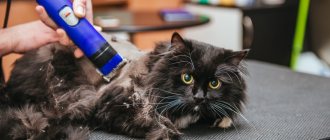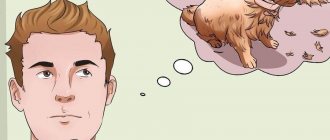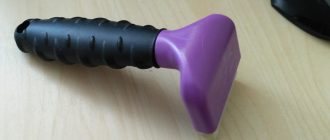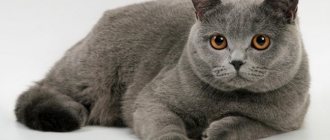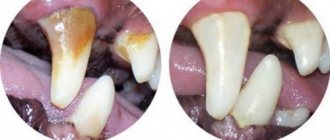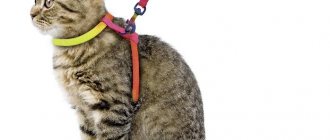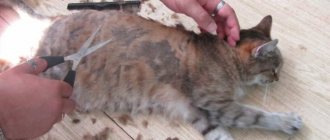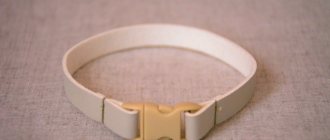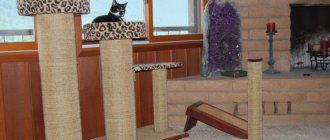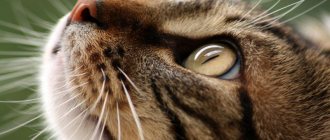Regular pet care includes not only feeding, but also hygiene procedures, in particular taking care of the fur. Grooming cats and female cats is especially important for long-haired breeds living at home. Excess hairs not only spoil the environment, but often serve as a cause for concern about the health of your pet. When a cat washes itself, hair gets into the stomach, which often causes intestinal obstruction. This can lead to serious health problems, even death. The following review will tell you everything about the procedure for grooming cats, the rules for choosing tools, and conducting a “cosmetic” session.
The need for cat grooming - pros and cons
Most often, the need to groom a cat is due to the numerous tangles that have formed on the animal’s body due to lack of proper care. There are stories when tramps picked up from the street were found to have numerous ulcers, sores, worm eggs, external parasites and their larvae under matted hair.
In the case of weeping ulcers and lichen, the pet must be frequently treated with medicinal ointments and compositions, and it can be difficult to reach the skin through the hair.
In addition, with abundant tangles, the cat’s skin tightens, and the animal experiences unpleasant and even painful sensations. Sometimes it becomes necessary to trim your pet due to too many hairballs forming in the gastrointestinal tract, which can cause serious diseases of the digestive system.
Another common argument from owners in favor of this procedure is that the climate is too hot. Constant temperatures above +35 °C are usually difficult for animals to tolerate.
We recommend reading the article about grooming cats.
Often in breeds with special coats, the hair around the anus and genitals becomes very dirty when using the litter box. Of course, you can often wash your pet or trim problem areas, but the aesthetics of the appearance suffer. Read the article about long-haired breeds.
Sometimes you have to resort to cutting due to heavy shedding, when the whole house is littered with hairballs. This is especially true if there are small children or people with allergies in the apartment. But as a rule, the seasonal change of coat passes quickly, and in other cases you should be concerned about the health of the animal and consult a veterinarian. Severe hair loss in a cat can be caused by a lack or excess of vitamins in the diet, or some other pathologies.
Sometimes owners of older animals groom their cats because it is difficult for them to care for their fur themselves.
Many owners prefer aesthetic rather than hygienic haircuts, which give their pet a well-groomed and even glamorous look. Thus, the benefits of grooming cats in many cases are undeniable; grooming often transforms the most homely pet.
In any case, before deciding to groom a cat, the owner should also think about the negative side:
- To one degree or another, the thermoregulation of the cat’s body is necessarily disrupted, because the skin’s natural breathing process is rudely interfered with.
- Some experts believe that cat hair that grows back after being trimmed is of poorer quality.
- These animals usually do not tolerate the procedure itself well and often become depressed and fall ill. There are even isolated cases of a pet dying during a haircut due to heart failure. Read about stress in cats.
- After removing the fur with a clipper or scissors, the cat's hair, as a rule, grows back very slowly and does not always return to its previous length.
- In the first days after cutting, the hairs are very prickly and cause inconvenience to both the animal and the person.
In principle, if the animal is healthy, then it does not need a haircut under any circumstances. Cats groom themselves very often, almost constantly, which provides excellent coat care. Regular brushing will also help. Read the article about how to comb cats and kittens correctly.
When licking, cats realize many instincts - they evenly distribute and lick their own scent, calm down, and relieve stress.
The condition of the skin and coat are the main signs of a pet’s health. At the first symptoms of dull hair, the owner should reconsider the cat’s diet and not grab the scissors.
It must be remembered that grooming a cat is not the norm, it is a radical measure, permissible in case of urgent need - skin diseases and abundant mats. In all other cases, this procedure is not mandatory.
Why cut your cat's hair?
The main purpose of grooming animals is to care for their fur.
Cats have a natural need to constantly care for their fur coat. But very often this is not enough, especially for fluffies with a fur length of more than 3 cm. Special care is recommended for such pets, including regular combing, removing tangles and trimming excess hair.
Cat trimming procedure
The cat trimming procedure consists of the following steps:
- It is necessary to fix the pet in a position lying on its side, holding it by the hind and front legs.
- First of all, the tangles are cut off with scissors. After this, they continue cutting the hair on the sides of the body and back using a clipper.
- When trimming fur from the belly, you should carefully avoid the nipples and intimate areas. Experts recommend first cutting the hair in intimate areas with scissors and then completing the manipulation with a clipper. It must be remembered that cats' skin is very thin and easily injured. Therefore, while working with the machine, you need to tighten it so that skin folds do not get under the blades.
- At the end of the procedure, the cover on the paws is cut off.
- The hair on the animal's head is not trimmed; it is possible to shape it with thinning scissors. It is strictly forbidden to trim the mustache, as it is an important organ of touch.
- Tail trimming is carried out at the request of the owner.
If you can’t cut your cat’s hair in one procedure, you can divide it into several stages. This will allow the pet to avoid unnecessary stress, and the master from bites and scratches.
After grooming, the animal must be bathed and dried with a hairdryer. If your cat is afraid, you can remove cut and stuck hairs by wiping it with a damp cloth or chamois cloth. During the cold season, you should create a comfortable microclimate without drafts in the room where the pet is.
Breeds that often need grooming
Typically, cats of semi- and long-haired breeds suffer the most from matting and the formation of tangles. Even if you miss even one brushing, for example, of a Persian, problems will definitely arise. The animal's blood circulation is impaired due to skin tightness, it becomes nervous, experiences discomfort and itching.
Read the article about why a cat can scratch itself until it hurts.
Therefore, most often, haircuts to remove tangles are used for:
- Kurilian bobtails;
- Neva Masquerade;
- Maine Coons;
- Norwegian forest;
- Siberian;
- Turkish Angoras;
- Persian;
- ragdolls.
It should be remembered that Persians have hair in the undercoat and the main coat of the same length, and cutting for this truly long-haired breed does not disrupt heat exchange. Therefore, the grooming procedure is not dangerous for their health. But the semi-long-haired Maine Coon, Siberian and Norwegian forest cats have axial and undercoat hair of different lengths. Due to this, a layer of air is naturally created, protecting the pet from overheating and excessive cooling.
The texture and structure of the hairs here are also different, so cutting these breeds must be done very carefully and only as a last resort.
Short-haired breeds usually do not require trimming at all. The only exception is the British.
It is easier to prevent the formation of tangles than to cut them off later, ruining the aesthetic appearance of your pet. Moreover, you should not subject him to a more beautiful general haircut, disrupting the heat exchange of the skin and causing unnecessary risks to the cat’s health.
Types of haircuts
There are 2 types of haircuts:
- Hygienic.
- Model.
The first type, as can be understood from the name itself, is aimed at cat care, as well as for the treatment of certain diseases.
The second type is already a trend in fashion. Many owners of cats of different breeds regularly trim their pets on their own or in special salons. Thus, they give them an original look and style.
Necessary accessories and preparation for a haircut
If, nevertheless, there is an urgent need to groom a cat, but the owner is afraid of injuring the pet and is not sure that he can cope with the procedure, you can contact grooming specialists in a professional salon. This operation is also included in the price list of many veterinary clinics.
In case of self-grooming at home, the animal owner must first purchase the necessary tools and equipment and perform certain actions:
- Prepare a table or wide ironing board as a grooming area.
- Buy large and small scissors with rounded tips and sharp blades made of high-quality steel, a furminator.
- Choose and buy a trimmer - a special machine for cutting animals. The optimal nozzle for cats is usually 3 mm. The device cannot be used on human hair, as cats have a completely different hair structure. You also need to decide on the power of the device, so for Persians it needs high (45-60 W), for semi-long-haired pets you can limit yourself to 20 W.
- Make sure there is minimal stress for the cat. Thus, more powerful rotary trimmers make a lot of noise and frighten the animal; it is worth choosing a model with a mains adapter and a vibration-type motor.
- The cat may need to be given sedatives the day before the procedure. It should be remembered that synthetic substances and anesthesia will harm your pet; it is better to use herbal products.
- Sometimes it is advisable to use an Elizabethan collar - a special device worn around the animal’s neck. It can prevent a nervous cat from biting and injuring the groomer. A special muzzle can also help - a cap that covers the cat’s mouth and eyes.
- Most likely, you will need a special machine for cutting hair on the paw pads, face, around the genitals, and in other hard-to-reach places.
- It is necessary to provide thinning scissors and a massage brush to bring the hairstyle to its final shine. Also, for some (especially short-haired breeds) cats, you will need velvet for polishing, wet wipes to remove excess hair, or a special glove.
- It is also worth making sure that you have on hand the means to provide first aid to your pet if an accidental injury to the skin occurs. It is better not to use alcohol-containing compounds (iodine), but to purchase hydrogen peroxide, Miramistin, Chlorhexidine, and special talc.
You should invite another person as an assistant, and the pet itself should have its claws trimmed at least 24 hours in advance.
Required Tools
A hygienic grooming of a furry pet can be done using only scissors as the main tool. Naturally, they should have rounded ends, be well sharpened and not very large in size.
But it is preferable, of course, to use a trimmer (a special hair clipper). It is completely safe and you won’t be able to inadvertently injure your pet, and it does the job much faster and easier. The only problem that can become an obstacle is the noise the machine makes. Your pet may get scared of the device and simply run away. There are regular trimmers and ones for hard-to-reach places.
Additionally you will need:
- Comb with rounded teeth to avoid scratching the animal.
- Hydrogen peroxide and cotton wool in case you accidentally injure your pet.
- Bedding, for example, an old towel, which will have to be thrown away after the event.
- A table or couch is any horizontal surface where you can comfortably place your cat.
- A distracting object that the pet can engage in during the procedure, for example, a toy, a dental bone.
Which machine to choose for grooming a cat
Retail chains offer a very wide range of devices for grooming pets, from very expensive and functional to budget ones. The disadvantage of inexpensive models is, first of all, their unstable and indelicate operation - such models can cut fur poorly or pull out hair. Another disadvantage of budget models is that they overheat during use, and you can simply burn your pet. Inexpensive trimmers have a short service life.
As mentioned above, there are regular trimmers and ones for hard-to-reach places. The latest models are distinguished by their small size and shorter blades (no more than 2 cm). A similar device can be used to treat areas of anatomical curves, ears, muzzle, and areas under the tail. But this is more of an auxiliary tool; it is impossible to give a full haircut with it. Conventional trimmers are used for these purposes.
For representatives of especially fluffy breeds with a thick undercoat (Persians, exotics, etc.), choose devices with a power of at least 45 W, they will not overheat and can cope with thick hair. Pay attention to the blades: they should be wide and sharp. The speed and delicacy of the work depends on the sharpness of the blades. For cats with not very thick and long hair, you can use clippers with a power of 20 W or more.
A very useful option for the trimmer is the ability to automatically adjust the cutting surfaces. When choosing a device in a store, pay attention to this; not all models have this function. With a minimum length of cutting surfaces of 0.5 cm, the length of the pet's hair after cutting will be equal to 0.5 cm. It is dangerous to use devices with very small blades yourself at home - you can injure the animal's skin.
Mains-powered electric trimmers are preferable to those that rely on batteries or a battery. They guarantee stable and long-term operation of the device. If you frequently have to pause and turn off the device while cutting, the battery or batteries may drain very quickly. An even more convenient option is models that have both a battery and a network connection. The noise level produced by the device is also important. The quieter and more pleasant the device is, the more the cat will like it.
Make sure that the machine is comfortable to hold in your hands. It should be moderately light and moderately heavy. It is difficult to ensure smooth movement with a device that is too light, and a device that is too heavy will quickly tire your hand. Therefore, try to find a “golden mean”.
Pay attention to the shape of the handle; it should fit comfortably in your hand and not slip out.
Be sure to check the device before purchasing, especially for overheating and foreign odors.
How does a cat feel about haircuts?
Trimming the hair on cats often makes grooming much easier for the pet owner and reduces house cleaning time. At the same time, the pet himself never expresses pleasure from this procedure.
It is always stressful to one degree or another. For some individuals it is stronger, at the limit of their capabilities, while others tolerate it more easily. But almost all cats love brushing and even often fall asleep during this procedure if it is carried out carefully and with love.
The Dragon
Therefore, it is advisable to make a decision about the need for a haircut, taking into account the pet’s personal qualities, and if the procedure cannot be refused, and the cat is very nervous, give him sedative drops and involve several people to help.
Tools for grooming furry cats
Most often, sharp, well-sharpened, medium-sized scissors are used for this hygienic procedure at home. Is it possible to cut a cat's hair with a regular clipper? A clipper is the most convenient in this procedure, because with it it is almost impossible to injure the animal. Its only drawback is the noise during operation, which can frighten the cat. That is why it is recommended to choose the most silent models.
In addition, you will need the following tools and accessories:
- A comfortable comb (preferably with soft teeth that will not cause unnecessary distress to your pet).
- Hydrogen peroxide (if you accidentally hurt your cat).
- Scissors (if you still decide to use this tool, it is advisable that the scissors have rounded ends).
- Comfortable horizontal surface (for example, a desk).
- An unnecessary towel that should be placed on your desk (after which you simply collect it and throw it away).
- The cat’s favorite toy (with its help you will distract the animal from a not very pleasant process).
Features and frequency of cat haircuts
Often glamorous pet owners strive to update their model hairstyles every month, which often causes severe stress for cats.
Animals should not be cut or bathed frequently. These procedures, in addition to being beneficial, also cause harm and worsen the condition of the hair and the entire integument.
The frequency of haircuts in case of urgent need depends on the speed of hair regrowth. Usually, a pet becomes completely overgrown in 4-6 months and it is enough to carry out the procedure 2-3 times a year.
It is better to comb your pet regularly, because tangles usually form under the paws (armpits), in the groin area, behind the ears, on the tail and neck.
Haircuts for cats come in two categories:
- hygienic;
- model.
The goal of the former is to prevent skin diseases, remove tangles, protect the cat from overheating, and solve other veterinary problems (diseases of the digestive tract, high secretory activity of the anal and fatty glands, old age).
Model cat hairstyles are for decorative purposes only. Sometimes they are performed before special cat shows. Typically, such haircuts are done in the spring, 3-4 months before the competition, since the skin takes a long time to grow and does not look better immediately after the procedure.
The most popular models are:
- French Lion - the back of the body and tail are cut short, but a pompom is left at the tip. I form a kind of mane on my head and neck.
- Puma is a simplified version of the Leo hairstyle, in which the tail is completely (almost bald) cut off.
- The dragon is the most creative but harmful cat hairstyle for your pet. Various symbols and signs are formed on the animal’s body - letters, ornaments, patterns, and other elements, for example, a dragon crest. Very often, some areas are painted in different colors. After such a haircut, hair grows unevenly, and thermoregulation is greatly impaired.
- Graduated haircuts are Socks, Knee Highs, Puss in Boots, Harlequin, Modern, Continental Chic.
Puss in Boots
In most developed countries, model haircuts for cats are condemned, since they are performed solely at the whim of the owners and can cause significant harm to the health of pets.
Why and how often should you cut your cat's hair?
The most common reason why cats are cut is the owner's desire to give the animal an unusual look. Model pet haircut is one of the modern fashion trends. Cats are also given a haircut before participating in professional exhibitions. Some owners believe that cutting their furry pet's hair is necessary in order to relieve it of discomfort in hot weather.
However, shortening the fur due to heat is not practical for many felines. The coat of cats is a kind of regulator that helps with excess heat and cold. Persian cats are most often affected by hot weather. However, cats are cut for other reasons:
- Fur stains that cannot be removed by bathing. The pet can get dirty with machine oil, paint, and building materials. In some cases, the animal's fur needs to be shaved.
- Formation of tangles that cannot be combed out. Sometimes shedding occurs so intensely that the owner does not have time to remove the fallen fur. The tangles cause discomfort to the animal, and chafing and rashes can form underneath them. Pieces of fur can get into your pet's stomach when he tries to lick them, which will lead to the formation of hairballs in the stomach.
- The animal is not able to care for its fur. If the pet is weakened, long hair will contribute to overheating.
- Long intense molting. A haircut will make it easier for the owner to care for the pet. Often they resort to eliminating long hair when a baby appears in the house. Lost hairs can rise into the air and settle on children's objects.
- The need for medical procedures. When treating dermatitis, burns and other pathologies, it is sometimes necessary to apply ointments and creams. Long hair will prevent this. Also, after a haircut, it is easier to observe the results of therapy.
Features of summer haircuts
Most often, owners have a desire to cut their cat's hair in the summer, when the pet is languishing from the heat. Even in this case, cutting is not advisable. It is better to provide the animal with free access to water and a cool place to rest, for example, a tiled floor in the bathroom or an area under the air conditioner.
It is strictly forbidden to cut pets very short or bald. When using small attachments (1 mm or less), there is a high probability of injury to the skin. In addition, an animal completely devoid of hair suffers even more from overheating and can even get burns.
Nature itself took care of protecting the cat by providing a special air cushion between the cover and the skin. Usually the animal easily adapts to any weather conditions.
Cats walking outside have a particularly hard time with short summer haircuts. In addition to overheating and burns, they are at risk of various skin diseases, practically devoid of natural cover.
For cats that do not leave the apartment and lead a sedentary lifestyle, if they have very long and thick hair, like Persians, summer hair shortening is quite possible.
All owners of British and Scottish Fold cats with thick, plush fur are simply divided into two categories. These are those who regularly groom their pets in the summer, and those for whom this procedure is unacceptable under any circumstances.
How to cut a cat's hair at home?
It is better to choose small and convenient scissors as the material at hand. If your pet has thick hair, then it is better to carry out the procedure using a clipper. But usually such devices buzz loudly and scare the animal. Therefore, when choosing a machine, choose the quietest copy. Ideally, this hygienic and aesthetic procedure should be carried out several times a year (4-5 months will be a break). Be sure to trim your pet before the summer heat begins. Animals with thick fur do not tolerate heat well. Make life easier for them and yourself. So, put aside your fear and start cutting hair. Prepare not only a tool (clipper, scissors, comb), but also medications in case of an accidental cut.
Not all cats will be happy with the procedure. Some cats will start screaming, running away and showing aggression at the sight of a clipper and scissors. If you have just such a disobedient pet living in your house, then involve another member of the household in the haircut. You will have to hold the animal's limbs and head with your hands, but do not tie up the unfortunate cat. The haircut usually starts from the sides, then goes to the back, and from there the clippers (scissors) are applied to the tummy. Especially large cleats of wool are initially cut off with scissors, otherwise the attachment for the clipper may break. Yes, and it will be more convenient. The belly should be trimmed carefully and delicately, especially in the nipple area.
To make it more convenient to work, use your fingers to stretch the skin of the cat. This will help you avoid unnecessary cuts. If you get to the paws and tail, but don't leave them completely bare. This way your cute pet will look a little like a lion cub. Of course, you don't need to shave your cat's head either. After grooming, be sure to bathe the animal and dry it with a hairdryer. And don't worry yourself, otherwise your trembling hands will harm the cat.
In this video you can clearly see how a cat is groomed, more professionally, already “with a full hand.” And in the second video, the haircut scene is more interesting, but, let’s say, less professional, although quite acceptable. The main thing here is to know your pet, and if he is restless and can scratch or even bite, then before grooming the cat you need to take measures for your own safety, namely, perform the procedure with an assistant, and approximately as shown in the first video.
Video: Grooming a cat at home
Cat grooming rules
In order to carry out the procedure of grooming a cat at home as painlessly as possible for everyone, you must follow certain rules:
- Having prepared the place and all the necessary tools, the groomer should put on the clothes in which the haircut will be carried out. It is advisable not to leave any exposed skin, as your pet may scratch.
- You should pet and calm the cat, help him get used to the buzzing of the machine. Give sedatives if necessary.
- Then the pet must be thoroughly combed with a fine-toothed comb and then with a fine-toothed comb to determine the length of the haircut. If the hair is not very tangled, then it should be trimmed minimally.
- The animal is placed on its side, and the assistant presses it firmly to the table, fixing the front legs with one hand and the hind legs with the other.
- First, the tangles are cut off with special scissors or a furminator.
- Use small scissors or a trimmer, like manicure scissors, but with rounded ends, to treat hard-to-reach places - armpits, interdigital space, groin area, areas around the nipples.
- Then a 3 mm attachment (2 mm is extremely rare) is installed on the clipper and the main procedure begins. If there were few tangles, then you can get by with large scissors and a comb.
- The sequence of the procedure is always as follows - first the sides, then the back and stomach. The skin on the belly is the most sensitive, while other areas are being cut the animal usually calms down a little and more calmly tolerates the process of trimming the hair in the most unprotected place.
- The tail is processed last. If there is no need, do not touch it at all or carefully remove the most protruding hairs with scissors.
- On the face, if this is not a model haircut, but a hygienic haircut, the hair is not touched.
- If necessary, after completing the main cutting process, you can go through your pet's coat with thinning scissors.
- The cat's hair is cut in the direction of its growth. This lengthens the procedure somewhat, but causes the least discomfort for the pet.
- Only animals that are accustomed to shearing and can easily tolerate the procedure can be quickly trimmed against the direction of hair growth.
- During the process, especially if the pet is nervous, you need to stop, caress and stroke the animal, and talk to it in a soothing tone.
After finishing the grooming, it is better to bathe the cat, dry the fur with a towel and comb it thoroughly, removing excess hair with a massage brush. Now you need to calm the pet down again, praise and caress it, give it a treat or feed it.
Usually in a grooming salon the whole procedure takes 30 minutes at most, but for the owner it can take much longer - an hour or an hour and a half.
Haircut instructions
First, the table is treated with an antiseptic and the instruments are disinfected. Then the claws are trimmed. The cat is secured so that it lies still. When he tries to escape, they put a plastic collar on him. First, use a clipper (nozzles No. 3-5) to cut the hairs on the sides, then treat the back and stomach. They act very carefully near the nipples, in the perineum.
For the armpits, change the nozzle to No. 2. Shave the paws starting from the top, going down as far as necessary. The hair on the tail is cut so that 1/3 of the hair remains, at least a tassel. To avoid damage to the skin, it is slightly stretched.
The tangles are cut off with scissors before the hairstyle. If missed during the preparatory examination, then as soon as it is found. The coat can be cut with or against hair growth. When the procedure is completed, the cat is wiped with a damp cloth or doused with warm water and washed with shampoo. Then dry with a towel or hairdryer.
Options for common haircuts
The French Lion hairstyle is very popular . This hairstyle suits any cat, but cats with thick, long hair look especially impressive. It is ideal for the summer heat. The cat is cut like a lion, leaving only the mane, a tuft on the tail, and hair on the paws below the knees. Other types are also popular.
Fashionable haircut options
Dragon has become one of the most popular fashionable haircuts . The coat is trimmed with narrow or wide triangles, forming a mohawk. Paws and head are not cut. Dragon models are different. It’s difficult to do a fashionable haircut on your own; it’s better to take your cat to a specialist or invite a groomer to your home.
Partial haircut options
These include haircuts that are close to the natural cover or with partial shaving. For example, Continental, Harlequin, Modern . Such haircuts emphasize the extravagance of the cat.
Tips for owners
Experienced groomers and breeders recommend that owners who decide to groom their pet on their own:
- Do not touch the tail during the procedure.
- It is especially gentle and careful to cut the fur on the belly; this is the most vulnerable place for cats; in addition, there are many folds that an inexperienced person can easily snag with scissors or a clipper.
- Psychologically prepare the cat. It is better to accustom him to the sight of scissors, a trimmer, and a grooming table from an early age.
- You should regularly, long before the first haircut, place the cat on the table and gently comb it. In this case, she will not be afraid of this place and will calmly endure the procedure.
- It is advisable to use a silent device with low vibration levels.
- It is necessary to carry out the haircut in two or three stages, giving the pet time to rest, and always talk to him affectionately during the process.
- Never touch the mustache, eyebrows, ear hairs and hair on the head. The muzzle is cut only by experienced groomers when creating model hairstyles. Vibrissae are vital for animals to orient themselves in space.
- Never cut cats bald.
- If it is possible to carry out care without cutting, it is better to refuse it.
Professional grooming
When it is not possible to trim or shave a cat on your own, or when it is being prepared for exhibitions, competitions, or photo shoots, it is recommended to contact specialized salons or professional groomers. They have experience and special tools, which eliminates damage to the vibrissae and skin trauma.
In salons, a haircut takes from 40 minutes to an hour - it depends on the complexity. To prevent the cat from being nervous about a trip or an unfamiliar place, you can call a specialist home. Anesthesia is rarely used; it disrupts the functioning of the cardiovascular and respiratory systems. The cost of a haircut varies from 700 to 1000 rubles.
Salon prices offer a full range of services - from ear cleaning to final styling. A professional groomer has a larger selection of tools - several types of combs, furminators, shaving machines, and different attachments. The photo shows how difficult it is to do haircuts. Without experience, you can even cripple an animal on your own.
If necessary, the cat is given an injection of a sedative. After the haircut, they will tell you how to properly care for it and when it is necessary to do it again. Only professionals can do a model haircut before a competition; at home, the risk of ruining it greatly increases, and you can injure the animal.
Is it possible to shave a cat's head? This cannot be done unless necessary, since wool saves the animal from the sun, heat, hypothermia, and accidental damage. It is strictly forbidden to shave your head. There are many sensitive vibrissae that cannot be injured. Cats are shaved bald when their fur is stained with substances that are difficult to wash off (cement, mortar, polyurethane foam), before surgery, or when the body is severely damaged by parasites.
How long does a cat's hair grow after shaving? This depends on various factors - the age of the animal, current diseases, nutrition. The fur usually grows back in 6 months. But in case of chronic diseases, deficiency of useful microelements, the cover takes several years to recover.
Grooming cats should be done carefully, carefully, so as not to injure the animal. The pet gets used to its new appearance in a few days. If you have any doubts about your abilities, it is better to contact a professional groomer.
Possible consequences of a haircut
People are accustomed to thinking that after cutting their hair, their hair grows faster and is thicker. But in cats, the effect is strictly the opposite - hair often grows back after trimming very slowly and unevenly. In addition, the coat may change color, usually becoming darker.
The structure of the hair almost always changes, it becomes thinner and more fragile. Some animals take haircuts so hard and experience so much stress that they can get sick. Therefore, in no case should we assume that cat grooming is a harmless and always acceptable procedure.
It is permissible to use this method of care only in extreme cases; it is better to comb your pet regularly, preventing the formation of tangles.
Brushing and bathing the cat after grooming
After the haircut is finished, you need to comb the cat to remove the cut hairs and bathe it with shampoo for cats.
If the animal is too overexcited, it is better to simply wipe it with a damp towel so as not to traumatize the cat’s psyche. If your cat is not afraid of a hairdryer, you can dry the fur using it. But under no circumstances use hot air, this will cause unnecessary stress. Only warm air can be used.
Let's go to the grooming salon
When the owner of a furry purr does not have enough skills and opportunities to groom the animal on his own, a decision is made to change the image of the pet by the masters of the grooming salon.
Grooming experts will do the job efficiently and quickly, with minimal discomfort for the cat.
When deciding to take your pet to the cat barber, you should remember the following nuances:
- During the trip, the cat may become agitated and behave aggressively in the future;
- the cost of a haircut depends on the type of hairstyle - model ones are more expensive than hygienic ones (the latter cost from 1-1.5 thousand rubles);
- the result depends not only on the skill of the groomer, but also on the condition of the animal’s coat;
- If the master is unable to cope with a frightened pet, a sedative injection may be offered, which does not have the best effect on the health of the purr.
READ Pyometra in cats - symptoms and treatment
The best way to change the appearance of your pet is to call a grooming specialist to your home. After all, in a familiar environment, it will be easier for the animal to endure the grooming procedure with minimal stress. And a professional hairdresser will not harm the cat, delicately removing excess hair from the most difficult and sensitive areas.
What do you need for a haircut?
To cut your pet's hair yourself, you will need:
- high table (can be replaced with an ironing board);
- scissors with not very sharp edges;
- animal clipper – should be chosen based on the type of cat’s fur;
- comb;
- hydrogen peroxide - to disinfect possible cuts.
Home grooming is best done with an assistant to minimize the risk of injury to both the animal and yourself.
Before cutting your hair, you need to prepare everything you will need in advance. So, for a quality home haircut, prepare:
- the surface where it will be produced is a table or ironing board;
- cat clipper;
- sharp scissors - regular and thinning;
- cotton wool, hydrogen peroxide or potassium permanganate in case of injury.
It is better to do the haircut with an assistant, especially at first.

